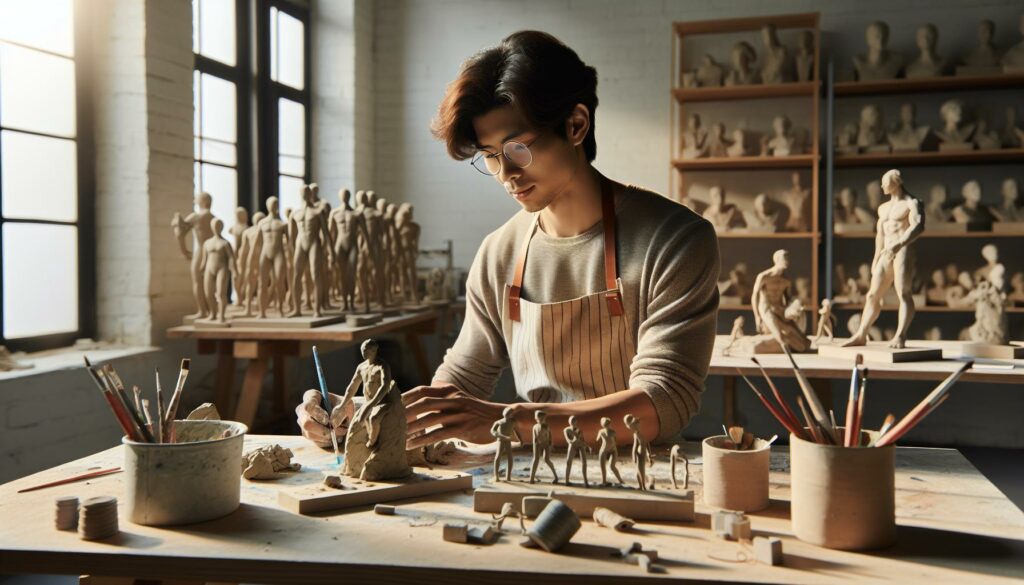Maquette sculpture fascinates me with its blend of artistry and craftsmanship. These small-scale models serve as a vital step in the creative process, allowing artists to visualize their ideas before committing to larger works. Whether for architectural designs or fine art, maquettes provide a tangible way to explore form, proportion, and material.
As I delve into the world of maquette sculpture, I find it’s not just about creating a miniature version of a larger piece. It’s about experimentation and innovation. The techniques and materials artists choose can vary widely, leading to unique interpretations and styles. Join me as I explore the significance of maquettes and their role in shaping the artistic landscape.
Key Takeaways
- Definition and Purpose: Maquette sculptures are small-scale models that serve as essential planning tools for artists, architects, and designers, allowing them to visualize and refine their ideas before creating larger works.
- Historical Significance: The practice of maquette sculpture dates back to ancient civilizations and has evolved through history, with notable contributions from artists like Michelangelo and modern figures such as Zaha Hadid.
- Versatile Techniques and Materials: Artists utilize a variety of materials—including clay, wire, wood, plaster, foam, and metal—and techniques such as modeling, carving, and casting to explore and develop their concepts in a tangible form.
- Role in the Creative Process: Maquettes facilitate experimentation by enabling artists to assess proportions, balance, and movement, leading to more innovative solutions that might not surface in full-scale projects.
- Influence on Larger Sculptures: These models play a crucial role in determining the scale and material choices for final pieces, ensuring that the artistic vision is accurately translated into larger works.
Maquette Sculpture
Maquette sculpture refers to a small-scale model used in the planning and design of larger artistic works. Artists, architects, and designers utilize maquettes to visualize concepts and test various ideas before committing to the final piece. These models depict the proportions, materials, and overall aesthetics of the intended work, allowing for exploration and experimentation.
Maquettes serve multiple purposes, including:
- Prototyping: Artists create prototypes to evaluate form and function.
- Scale Reference: These models provide a reference for size and volume, ensuring that the final work aligns with the artist’s vision.
- Material Exploration: Different materials can be applied in maquette construction, aiding in the selection of suitable ones for larger projects.
- Concept Development: The iterative process of refining concepts becomes clearer through the use of maquettes.
Maquettes vary in size and complexity, demonstrating a range of artistic techniques. Some artists choose clay, wood, or metal, each bringing distinct qualities to the model. The significance of maquette sculpture lies in its ability to bridge the gap between initial ideas and tangible works of art, making it an indispensable tool in the artistic process.
History of Maquette Sculpture
Maquette sculpture has a rich history, evolving from simple sketches to intricate models integral to the artistic process. Understanding its origins and contributions from notable artists highlights its importance in art and architecture.
Origins and Evolution
Maquettes date back to ancient civilizations, where sculptors crafted models to visualize large-scale works. The Egyptians used small clay models for statues, while the Greeks and Romans developed maquettes to plan monumental structures. During the Renaissance, artists like Michelangelo employed maquettes to refine their designs and proportions, further enhancing their creative process. By the 19th century, innovators such as Gustave Eiffel used maquettes to conceptualize engineering projects. This evolution established maquettes as essential tools in art and architecture, reflecting the growing intersection of creativity and engineering.
Notable Artists and Their Contributions
Several artists shaped the development of maquette sculpture through their innovative practices.
- Alberto Giacometti: Known for elongated figures, his maquettes showcased the essence of human form while exploring spatial dynamics.
- Henry Moore: Created numerous maquettes in different materials, these small models informed his larger works, emphasizing organic forms.
- Zaha Hadid: Used digital technology alongside physical maquettes, merging traditional and modern techniques to push architectural boundaries.
These contributions demonstrate how maquettes serve as a bridge between concept and completion, influencing various artistic movements and practices.
Techniques and Materials
Maquette sculpture employs various techniques and materials that significantly influence the artistic outcome. These elements contribute to the creative exploration and refinement process of larger works.
Common Materials Used
- Clay: Highly malleable, clay allows for detailed shaping and adjustments. It’s ideal for capturing fine details before casting in other materials.
- Wire: Light and flexible, wire forms frameworks for more complex structures. It supports the creation of skeletal forms and can be easily manipulated.
- Wood: Wood offers durability and a range of textures, suitable for both carving and additive techniques. It’s commonly used for structural maquettes.
- Plaster: This material is perfect for creating hard surfaces and can be molded easily. Plaster can mimic textures and finishes found in larger sculptures.
- Foam: Lightweight and easy to cut, foam is excellent for rapid prototyping. Its softness allows for quick iterations in design.
- Metal: Often reserved for more permanent maquettes, metal provides strength and longevity. It can be used to showcase the final intentions of a larger piece.
- Modeling: This subtractive technique involves adding material to create forms. I shape the medium progressively, allowing for real-time adjustments and designs.
- Carving: Involves removing material from a solid block, it creates clean lines and precise forms. I often use carving for wood and stone maquettes.
- Constructing: This additive method assembles various materials to form a complete sculpture. I combine components to layer textures and shapes effectively.
- Casting: This technique involves pouring liquid material into a mold to replicate shapes. I use casting to create maquettes that may lead to larger bronze or resin pieces.
- Mixed Media: By blending various materials and techniques, I can enhance the visual and textural complexity. It allows creative freedom in exploring new ideas.
These materials and techniques shape the maquette’s role in the artistic process, providing a foundation to innovate and refine ideas before scaling them up.
The Importance of Maquettes in Art
Maquettes play a critical role in the artistic process. These small-scale models enable artists to translate ideas into tangible forms, refining concepts before embarking on larger projects.
Role in the Creative Process
Maquettes serve as invaluable tools for experimentation. Artists use them to visualize and explore ideas, iterating on themes and forms. Creating a maquette allows me to assess proportions, balance, and movement in a structured manner. By manipulating materials like clay, wood, or plaster, I can quickly implement changes, leading to innovative solutions that might not emerge in a full-scale project. This iterative process promotes a deeper understanding of composition and spatial relationships.
Influence on Larger Sculptures
Maquettes significantly impact the design of larger sculptures. They act as a reference for size and scale, ensuring the final piece retains the intended form and essence. When I work with a maquette, I can evaluate how various materials interact and determine the most suitable choices for the final work. Historical examples, like Michelangelo’s early sketches translating into monumental sculptures, illustrate this influence. Maquettes not only bridge concept and completion but also guide the overall vision of the larger piece, making them essential in the sculpting journey.
Creative Artists
Maquette sculpture stands as a vital element in the creative journey of artists. These small-scale models not only facilitate the exploration of ideas but also serve as a testing ground for innovation. I’ve seen firsthand how they bridge the gap between concept and reality, allowing for a deeper understanding of form and function.
The versatility in materials and techniques used in maquettes fosters a unique environment for experimentation. This process ultimately enhances the quality of larger works, ensuring that each piece resonates with the artist’s original vision. Embracing the role of maquettes can lead to transformative insights, making them an essential tool for anyone looking to elevate their artistic practice.



